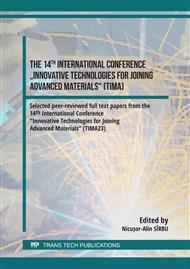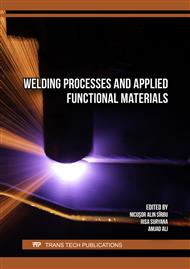[1]
M. Mortello, M. Pedemonte, N. Contuzzi, G. Casalino: Experimental Investigation of Material Properties in FSW Dissimilar Aluminum-Steel Lap Joints. Metals, 11(9):1474 (2021)
DOI: 10.3390/met11091474
Google Scholar
[2]
H. Ding, Q. Huang, P. L. Y. Bao and G. Chai: Fracture Toughness, Breakthrough Morphology, Microstructural Analysis of the T2 Copper-45 Steel Welded Joints. Materials. 13(2):488 (2020)
DOI: 10.3390/ma13020488
Google Scholar
[3]
P.K. Baghel: Effect of SMAW process parameters on similar and dissimilar metal welds: An overview. Heliyon. 8(12):e12161 (2022)
DOI: 10.1016/j.heliyon.2022.e12161
Google Scholar
[4]
N. Contuzzi, M. Rashkovets & G. Casalino: Numerical and experimental investigation of probeless friction stir spot welding of a multilayer aluminium alloy compound, Science and Technology of Welding and Joining, 28:8, 653-661 (2023)
DOI: 10.1080/13621718.2023.2193460
Google Scholar
[5]
P. Kah, M. Shrestha, J. Martikainen: Trends in Joining Dissimilar Metals by Welding. Applied Mech. and Mat. 440: 269-276 (2013)
DOI: 10.4028/www.scientific.net/AMM.440.269
Google Scholar
[6]
G. Casalino, P. Guglielmi., V. D. Lorusso, M. Mortello, P. Peyre, D. Sorgente: Laser offset welding of AZ31B magnesium alloy to 316 stainless steel. Journal of Materials Processing Technology. 242: 549 - 591 (2017)
DOI: 10.1016/j.jmatprotec.2016.11.020
Google Scholar
[7]
G. Casalino, M. Mortello, P. Peyre: Yb-YAG laser offset welding of AA5754 and T40 butt joint. Jour. of Mat. Proc. Tech., 223: 139–149 (2015)
DOI: 10.1016/j.jmatprotec.2015.04.003
Google Scholar
[8]
Y. Fang, X. Jiang, D. Mo, D. Zhu & Z. Luo: A review on dissimilar metals' welding methods and mechanisms with interlayer. The International Journal of Advanced Manufacturing Technology. 102:2845–2863 (2019)
DOI: 10.1007/s00170-019-03353-6
Google Scholar
[9]
G. Casalino, M. Moradi, M. K. Moghadam, M.K., A. Khorram, P. Perulli: Experimental and numerical study of AISI 4130 steel surface hardening by pulsed Nd:YAG laser. Materials, 12(19), (2019), 3136
DOI: 10.3390/ma12193136
Google Scholar
[10]
K. Martinsen, S.J. Hu, B.E. Carlson.: Joining of dissimilar materials. CIRP Annals. 64(2):679-699 (2015)
DOI: 10.1016/j.cirp.2015.05.006
Google Scholar
[11]
N. Contuzzi, M. Rashkovets, M. R. Mendagaliev, G. Casalino: Study on microstructure evolution in welded lap joint configuration of dissimilar advanced high-strength steels using low-frequency laser wobble welding. Heliyon, 9(11), (2023) Article number e21529
DOI: 10.1016/j.heliyon.2023.e21529
Google Scholar
[12]
A. Durgutlu, B. Gülenç, F. Findik: Examination of copper/stainless steel joints formed by explosive welding. Mater. Des. 26: 497–507 (2005)
DOI: 10.1016/j.matdes.2004.07.021
Google Scholar
[13]
S. Shiri, M. Nazarzadeh, M. Sharifitabar, M.Afarani: Gas tungsten arc welding of CP-copper to 304 stainless steel using different filler materials. Trans. Nonferrous Met. Soc. 22: 2937–2942 (2012)
DOI: 10.1016/S1003-6326(11)61553-7
Google Scholar
[14]
KD. Dheerendra: Dissimilar Metal Joining. Springer Nature Singapore Pte Ltd. (2023)
DOI: 10.1007/978-981-99-1897-3
Google Scholar
[15]
I. Magnabosco, P. Ferro, F. Bonollo, L. Arnberg: An investigation of fusion zone microstructures in electron beam welding of copper-stainless steel. Mater. Sci. Eng. A 424:163−173 (2006). http://
DOI: 10.1016/j.msea.2006.03.096
Google Scholar
[16]
Y. Meng, X. Li, M. Gao, X. Zeng: Microstructures and mechanical properties of laser-arc hybrid welded dissimilar pure copper to stainless steel. Opt. Laser Technol. (111):140-145 (2019)
DOI: 10.1016/j.optlastec.2018.09.050
Google Scholar
[17]
R. Feng, W. Zhao, K. Gan, M. Feng, Z. Li, Y. Pan, Z. Sun, J. Li: Investigation of interface microstructure and properties of copper/304 stainless steel fabricated by explosive welding. J. Mater. Res. Technol. (18): 2343-2353 (2022)
DOI: 10.1016/j.jmrt.2022.03.142
Google Scholar
[18]
RK. Bhogendro Meitei, P. Maji, A. Samadhiya, R. Karmakar, SK. Ghosh, SC. Saha: An experimental investigation on joining of copper and stainless steel by induction welding technique. IJPEM (21):613-621 (2020)
DOI: 10.1007/s12541-019-00284-w
Google Scholar
[19]
A. Durgutlu, B. Gülenç, F. Findik: Examination of copper/stainless steel joints formed by explosive welding. Mater. Des. 26(6): 497-507 (2005)
DOI: 10.1016/j.matdes.2004.07.021
Google Scholar
[20]
Y. Poo-arporn, S. Duangnil, D. Bamrungkoh, P. K. langkaew, C. Huasranoi: Gas tungsten arc welding of copper to stainless steel for ultra-high vacuum applications. J. Mater. Process. Technol. 277: 116490 (2020)
DOI: 10.1016/j.jmatprotec.2019.116490
Google Scholar
[21]
Istituto italiano della saldatura: Infusible electrode welding under inert gas protection. (2008), Genova, Italy. https://www.iis.it/it/saldatura-con-elettrodo-infusibile-sotto-protezione-di-gas-inerte-tig-versione-digitale
Google Scholar
[22]
X. Wang, J. Huang, Y. Huang, D. Fan, Y. Guo : Investigation of heat transfer and fluid flow in activating TIG welding by numerical modelling. Applied Thermal Engineering. Appl. Therm. Eng. 113:27–35 (2017)
DOI: 10.1016/j.applthermaleng.2016.11.008
Google Scholar
[23]
L. Wan, YX. Huang, S. X. Lü, TF. Huang, ZL Lü: Microstructure and properties of pure iron/copper composite cladding layers on carbon steel. Int. J. Miner. Metall. 23:920-927 (2016)
DOI: 10.1007/s12613-016-1307-z
Google Scholar



